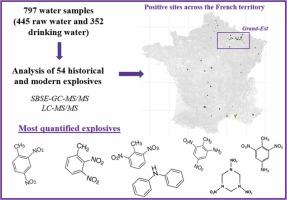Tracking the Invisible Threat: Persistent Explosive Residues in Raw and Drinking Water Bodies
IF 11.3
1区 环境科学与生态学
Q1 ENGINEERING, ENVIRONMENTAL
引用次数: 0
Abstract
This study provides a comprehensive nationwide assessment of explosive residues and their degradation products in French water resources and drinking water, including mainland and overseas territories. A total of 54 target compounds were selected based on historical usage, environmental persistence, and analytical feasibility. Between 2020 and 2022, water samples from nearly 300 sites—representing resources for 20–25% of the French population—were analyzed using high-performance liquid chromatography–tandem mass spectrometry (HPLC-MS/MS) and gas chromatography–tandem mass spectrometry (GC-MS/MS). Explosive residues were detected in 11% of the 797 samples, mainly in raw groundwater. Frequently identified compounds included 2,6-dinitrotoluene (2,6-DNT), diphenylamine (DPA), and hexahydro-1,3,5-trinitro-1,3,5-triazine (RDX), while others appeared less often but sometimes at high levels. These contaminants were largely linked to historical battlefields and former munitions storage areas, especially in the Grand-Est region bordering Germany. Degradation products like aminodinitrotoluenes (ADNTs) were more common in drinking water, possibly due to incomplete removal or transformation during treatment. Significant correlations between DNT, nitrotoluene (NT), and perchlorate suggest a shared origin tied to historical military activity. The findings highlight the need for continued monitoring of explosive residues, not only in France but in other regions affected by historical or current military operations.

追踪看不见的威胁:原始和饮用水体中的持久性爆炸性残留物
这项研究提供了法国水资源和饮用水中爆炸性残留物及其降解产物的全面全国评估,包括大陆和海外领土。根据历史使用情况、环境持久性和分析可行性,共选择了54种目标化合物。在2020年至2022年期间,使用高效液相色谱-串联质谱(HPLC-MS/MS)和气相色谱-串联质谱(GC-MS/MS)对来自近300个地点的水样进行了分析,这些水样代表了法国人口的20-25%。在797个样本中,有11%检测到爆炸性残留物,主要是在原始地下水中。经常被发现的化合物包括2,6-二硝基甲苯(2,6- dnt)、二苯胺(DPA)和六氢-1,3,5-三硝基-1,3,5-三嗪(RDX),而其他化合物出现的频率较低,但有时含量很高。这些污染物主要与历史上的战场和以前的弹药储存区有关,特别是在与德国接壤的大东部地区。降解产物如氨基二硝基甲苯(adnt)在饮用水中更为常见,可能是由于处理过程中不完全去除或转化所致。DNT、硝基甲苯(NT)和高氯酸盐之间的显著相关性表明它们的共同起源与历史上的军事活动有关。调查结果强调,不仅在法国,而且在其他受历史或当前军事行动影响的地区,都需要继续监测爆炸残留物。
本文章由计算机程序翻译,如有差异,请以英文原文为准。
求助全文
约1分钟内获得全文
求助全文
来源期刊

Journal of Hazardous Materials
工程技术-工程:环境
CiteScore
25.40
自引率
5.90%
发文量
3059
审稿时长
58 days
期刊介绍:
The Journal of Hazardous Materials serves as a global platform for promoting cutting-edge research in the field of Environmental Science and Engineering. Our publication features a wide range of articles, including full-length research papers, review articles, and perspectives, with the aim of enhancing our understanding of the dangers and risks associated with various materials concerning public health and the environment. It is important to note that the term "environmental contaminants" refers specifically to substances that pose hazardous effects through contamination, while excluding those that do not have such impacts on the environment or human health. Moreover, we emphasize the distinction between wastes and hazardous materials in order to provide further clarity on the scope of the journal. We have a keen interest in exploring specific compounds and microbial agents that have adverse effects on the environment.
 求助内容:
求助内容: 应助结果提醒方式:
应助结果提醒方式:


